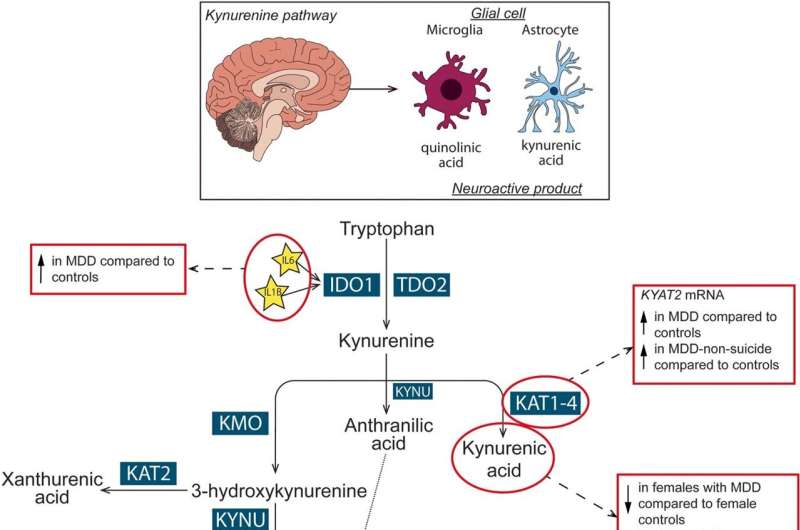This article has been reviewed according to Science X's editorial process and policies. Editors have highlighted the following attributes while ensuring the content's credibility:
fact-checked
peer-reviewed publication
trusted source
proofread
Major depressive disorder study finds differences between male and female brain processes at molecular level

Research published in Neuropsychopharmacology by a team of researchers at the University of Wollongong (UOW), National Institute of Complementary Medicine Health Research Institute and Neuroscience Research Australia has found molecular evidence highlighting important sex differences in the brains of people with major depressive disorder, with evidence of changes occurring specifically in the female brain, but not in males. The paper is titled "Sex- and suicide-specific alterations in the kynurenine pathway in the anterior cingulate cortex in major depression."
"We can no longer just look at depression with males and females together because, even at a fundamental level, the brains are so different biologically that when we group them all together for these studies, we miss so much," the study's lead author Dr. Samara Brown said.
Major depressive disorder (MDD) is a severe mental health condition that, in extreme cases, can lead to suicide. A team of researchers led by post-doctoral research fellow Dr. Brown and Professor Kelly Newell from UOW's School of Medical, Indigenous and Health Sciences and Molecular Horizons research institute has looked at the molecular characteristics of the brain n people with MDD, with a focus on the kynurenine pathway.
The kynurenine pathway is a set of chemical reactions that happen in the brain. These reactions produce various substances, including kynurenic acid (KYNA) which can affect how the brain signals and operates.
The paper covers research conducted over the last three years on 80 post-mortem brain samples and found that there were significant changes kynurenine pathway—indicative of the way the brain processes kynurenine—in the brains of both females with MDD and individuals with MDD who died from suicide.
This is the first molecular evidence in the brain of subgroup specific changes in the kynurenine pathway in people who had MDD.
The research found that in the brains of females with MDD, there was less KYNA. There is evidence that KYNA protects the brain, so lower levels could be problematic. This research is a step forward in understanding and potentially treating this complex condition.
The team showed that the kynurenine pathway functions differently in female and male brains of people with MDD. This research is a step forward in understanding and potentially treating this complex condition.
Dr. Brown said the research shows a need to consider sex differences in psychiatric research and treatment.
"There's a growing bank of evidence that we do need to stratify our analyses by sex across neurobiological research, especially for depression research, where females have twice the prevalence of the disorder compared to males," Dr. Brown said.
When the researchers looked at brain tissue from individuals with MDD who had died by suicide, they found even lower levels of KYNA in their brains compared to those with MDD who did not die by suicide. This could suggest a link between reduced KYNA levels and suicide. On the other hand, those with MDD who didn't die by suicide had more of a gene called KYAT2, which can produce KYNA and therefore prevent KYNA levels from dropping.
The team hopes their work will have implications for future drug research.
"What we're showing is that females and individuals at risk of suicidality may benefit from a specific type of medication that works with the kynurenine pathway. Whereas in comparison, males may not benefit from these same medications as we saw no evidence of alterations in the kynurenine pathway.
"The research is a step towards acknowledging that there are differences between MDD patients, and a one-size-fits-all approach won't work. We're really trying to understand the biology, what potentially drives some of the symptoms of depression.
"If we can understand at least some of what is going on in the brain, we can work out who might be more suited to diverse types of treatment."
More information: Samara J. Brown et al, Sex- and suicide-specific alterations in the kynurenine pathway in the anterior cingulate cortex in major depression, Neuropsychopharmacology (2023). DOI: 10.1038/s41386-023-01736-8



















